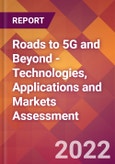Though, based on the industry insiders’ statistics, in 2020 market share of 4G networks was not more than 7%-12% on the global scale, the industry is already (2018-2021) supporting commercial 5G introduction in several market regions and applications.
This new radio access generation will be built on the existing infrastructure, which will be modernized and expanded with new technologies.
The 5G wireless communication system will be a converged system with multiple radio access technologies integrated together. It will be able to support a wide range of applications and services to comprehensively satisfy the requirements of the information society by the year 2020 and beyond. From the technology perspective, 5G will be the continuous enhancement and evolution of the present radio access technologies, and also the development of novel radio access technologies to meet the increasing demand of future. 5G can be characterized as data, connectivity and user experience.
There are two main views on 5G that exist today, which are frequently mixed together to form the basis of the 5G definition:
View 1 - The hyper-connected vision: In this view, 5G is seen as a blend of existing technologies (2G, 3G, 4G, Wi-Fi and others) that can deliver greater coverage and availability, higher network density in terms of cells and devices, and the ability to provide the connectivity that enables machine-to-machine (M2M) services and the Internet of Things (IoT).
View 2 - Next-generation radio access technology: This perspective outlines 5G in ‘generational’ terms, setting specific targets that new radio interfaces must meet in terms of data rates (faster than 1Gbps downlink) and latency (less than 1ms delay).
The first view is connected with a gradual transition of 3G/4G (and other) technologies to the 5G era with appropriate enhancements and extensions. Some of such technologies are the subject of this report analysis. Particular, the following technologies, their markets, industries and applications are addressed in connection with their transition to 5G (they are being bundled under the title of 5G despite of the fact that they are already being brought to market by vendors and deployed by operators):
CR/SDR - Cognitive Radio/Software Defined Radio
Though the concept of CR/SDR is well known and the industry supports these techniques for a number of years, the 5G era will bring new requirements to networks characteristics that can be easy to fulfill with CR/SDR. The 5G “Network of Networks” needs further development of the CR/SDR concept responding on particulars of 5G and using the existing base of smart radios.
Small Cells
It is expected that small cells will prevail in the 5G infrastructure due to advanced features that satisfy 5G requirements.
mmWave Radio
mmWave Radio will play an important role in the 5G RANs, allowing to explore the vast amount of free spectrum.
MIMO
Complex smart antenna systems such as MMIMO expected to be used extensively.
Visible Light Communication
VLC open several important applications, which were difficult to utilize in other spectrum windows.
The report also addresses general requirements to 5G networking and surveys current 5G standardization activities. It also contains the author’s survey of recently approved patents related to VLC and MIMO technologies.
The report intends for a wide audience of technical and managerial staff involved in the development of advanced wireless communications.
Table of Contents
Samples

LOADING...
Companies Mentioned
- Aeronix
- AirHop Communications
- AirNet Communications
- Airspan
- Alpha Networks
- Argela
- Beecube
- Blu Wireless
- Blue Danube
- Broadcom
- Carlson Wireless
- Casio
- Cavium
- Cisco
- CommScope
- Contela
- CRT
- Ericsson
- Etherstack
- Firefly
- Fraunhofer IPMS
- Fujitsu
- Gilat
- Green Hills
- Huawei
- Intel
- ip.access
- Juni
- L3Harris
- LightBee
- LVX
- Nakagawa Laboratories
- NEC
- NI
- Nokia
- Nutaq
- Oledcomm
- Outstanding Technology
- Peraso
- PureVLC-PureLi-Fi
- Qualcomm
- Radisys
- Samsung
- SELEX ES
- Spider Cloud
- Supreme Architecture
- Tektelic
- Tensorcom
- Thales
- TI
- TP-Link
- Wind River
- Xilinx
- ZTE
Methodology
Considerable research was done using the Internet. Information from various Web sites was studied and analyzed; evaluation of publicly available marketing and technical publications was conducted.
Telephone conversations and interviews were held with industry analysts, technical experts and executives. In addition to these interviews and primary research, secondary sources were used to develop a more complete mosaic of the market landscape, including industry and trade publications, conferences and seminars.
The overriding objective throughout the work has been to provide valid and relevant information. This has led to a continual review and update of the information content.

LOADING...








